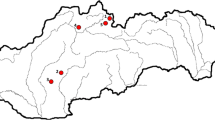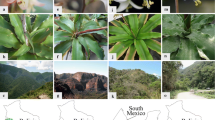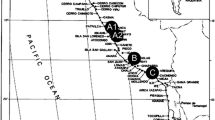Abstract
The sexual reproductive process in Pinus lambertiana has not been completely described, and previous attempts to generate hybrids with Pinus monticola and other North American pines have not been successful. The nature of incompatibility barriers between P. lambertiana and P. monticola is unknown. This needs to be understood if strategies are to be developed to overcome the said barriers. In this paper, development on interspecific crosses is compared with that on intraspecific crosses on the same parent trees. Pollen grains of both species germinated on the nucellus of both species within a week after pollination. Seed cone receptivity in P. lambertiana came approximately 2 weeks after receptivity in P. monticola, and this delay was perpetuated throughout ovule development in the first year of the reproductive process. Development of the second-year seed cones proceeded more gradually in P. lambertiana. However, seed cones reached maturity only for P. monticola x P. lambertiana. In both crosses, the barriers to hybridization occurred during the second year of the reproductive process. With the P. lambertiana as the seed parent, it was manifested through the failure of the megaspores at the free-nuclear stage to resume development. When P. monticola was used as the seed parent, the male and female gametes failed to fuse. Our results clearly show that the barriers to hybridization in these species occur before or at fertilization. However, the exact mechanisms behind these are still unknown. Based on the results of this study, we present several strategies to bypass the developmental barriers and possibly produce hybrid progenies.


Similar content being viewed by others
References
Belcher E, Vozzo JA (1979) Radiographic analysis of agricultural and forest tree seeds (contribution no. 31). In: Handbook on seed testing. The seed X-ray technology committee of the association of official seed analysts, Lansing, MI
Bingham RT, Hoff RJ, Steinhoff RJ (1972) Genetics of western white pine. USDA For Ser Res Pap WO-12. USDA Forest Service, Washington, DC, 28 p
Bruns D, Owens JN (2000) Western white pine (Pinus monticola Dougl.) reproduction: II. Fertilization and cytoplasmic inheritance. Sex Plant Reprod 13:75–84
Buchholz JT (1944) The cause of sterility in cross-pollinations between certain species in pines. Am J Bot 31(supplement):2–25
Chira E, Berta F (1965) One of the causes of interspecific incompatibility within the genus Pinus. Biologia 20:600–609
Critchfield WB (1966) Crossability and relationships of the closed-cone pines. Silvae Genet 16:89–97
Critchfield WB (1975) Interspecific hybridization in Pinus: a summary review. In: Fowler DP, Yeatman CW (eds) Symposium on interspecific and interprovinance hybridization in forest trees. Proc. 14th Meet. Can. Tree Improv Assoc, Part 2. Fredericton, NB, Canada, pp 99–105
Critchfield WB (1986) Hybridization and classification of the white pines (Pinus Section Strobus). Taxon 35:647–656
Critchfield WB, Kinloch BB Jr (1986) Sugar pine and its hybrids. Silvae Genet 35:138–144
Critchfield WB, Krugman SL (1967) Crossing the western pines at Placerville, California. Arbor Bull 30:78–81
Duffield JW (1952) Relationships and species hybridizing in the genus Pinus. Z Forstgenet Forstpflanzenzücht 1:93–100
Faure JE, Mogensen HL, Dumas C, Lörz H, Kranz E (1993) Karyogamy after electrofusion of single egg and sperm cell protoplasts from maize: cytological evidence and time course. Plant Cell 5:747–755
Fernando DD, Owens JN, von Aderkas P, Takaso T (1997) In vitro pollen tube growth and penetration of female gametophyte in Douglas fir (Pseudotsuga menziesii). Sex Plant Reprod 10:209–216
Fernando DD, Owens JN, von Aderkas P (1998) In vitro fertilization from co-cultured pollen tubes and female gametophytes of Douglas fir (Pseudotsuga menziesii). Theor Appl Genet 96:1057–1063
Fernando DD, Owens JN (2004) Development of an in vitro technology for white pine blister rust resistance. In: Sniezko RA, Samman S, Schlarbaum SE, Kriebel HB (eds) Breeding and genetic resources of five-needle pines: growth, adaptability and pest resistance; 2001 July 23–27; Medford, OR, USA. IUFRO Working Party 2.02.15. Proceedings RMRS-P-32. U.S. Department of Agriculture, Forest Service, Rocky Mountain Research Station, Fort Collins, CO, pp 163–168
Hagman M (1975) Incompatibility in forest trees. Proc R Soc Lond, B 313:326
Hagman M, Mikkola L (1963) Observations on cross, self-, and interspecific pollinations in Pinus peuce Griseb. Silvae Genet 12:73–79
Hashizume H, Kondo Y (1962a) Studies on the mechanism of fertilization in forest trees. I. Inhibitors to the growth of pollen tubes in the reproductive organs of Pinus densiflora. J Jap For Soc 44:43–48
Hashizume H, Kondo Y (1962b) Studies on the mechanism of fertilization in forest trees. II. Inhibitors to the growth of pollen tubes in the reproductive organs of Pinus thunbergii. Trans Tottori Soc Agr Sci 14:93–97
Haupt AW (1941) Oogenesis and fertilization in Pinus lambertiana and P. monophylla. Bot Gaz 102:482–498
Jaffe LA (1976) Fast block to polyspermy in sea urchin eggs is electrically mediated. Nature 261:68–71
Keng H, Little EL (1961) Needle characteristics of the hybrid pines. Silvae Genet 10:131–146
Kinloch BB Jr (1992) Distribution and frequency of a gene for resistance to white pine blister rust in natural populations of sugar pine. Can J Bot 70:1319–1323
Kinloch BB Jr, Dupper DE (1999) Evidence of cytoplasmic inheritance of virulence in Cronartium ribicola to major gene resistance in sugar pine. Phytopathology 89:192–196
Kinloch BB Jr, Parks GK, Fowler CW (1970) White pine blister rust: simply inherited resistance in sugar pine. Science 167:193–195
Kinloch BB Jr, Sniezko RA, Barnes GD, Greathhouse TE (1999) A major gene for resistance to white pine blister rust in western white pine from the western cascade range. Phytopathology 89:861–867
Kranz E, Bautor J, Lorz H (1991) In vitro fertilization of single, isolated gametes of maize mediated by electrofusion. Sex Plant Reprod 4:12–16
Kranz E, Lorz H (1993) In vitro fertilization with isolated, single gametes results in zygotic embryogenesis and fertilize maize plants. Plant Cell 5:739–746
Kriebel HB (1967) The timing of the incompatibility reaction of interspecific crosses of Pinus strobus L. Proc 14th IUFRO Cong 3:77–87
Kriebel HB (1972) Embryo development and hybridity barriers in the white pines (Section Strobus). Silvae Genet 21:39–44
Kriebel HB (1981) Maternal control over premature cone abscission of pines. Genetika (Belgrade, Yugoslavia) 10:269–276
Kriebel HB (2004) Genetics and breeding of five-needle pines in the eastern United States. In: Sniezko RA, Samman S, Schlarbaum SE, Kriebel HB (eds) Breeding and genetic resources of five-needle pines: growth, adaptability and pest resistance; 2001 July 23–27; Medford, OR, USA. IUFRO Working Party 2.02.15. Proceedings RMRS-P-32. U.S. Department of Agriculture, Forest Service, Rocky Mountain Research Station, Fort Collins, CO, pp 20–27
Kormutak A (1984) Some cytological and biochemical aspects of interspecific incompatibility in pines (Pinus sp.). Acta Dendrobiol 7:7–83
Krugman SL (1970) Incompatibility and inviability systems among some western north American pines. Proceedings of IUFRO Working Group on Sexual Reproduction of Forest Trees, Section 22, 13 pp
McWilliam JR (1959) Interspecific incompatibility in Pinus. Am J Bot 16:425–434
Owens JN, Bruns D (2000) Western white pine (Pinus monticola Dougl.) reproduction: I. Gametophyte development. Sex Plant Reprod 13:61–74
Owens JN, Molder M (1977) Seed-cone differentiation and sexual reproduction in western white pine (Pinus monticola). Can J Bot 55:2574–2590
Righter FI, Duffield JW (1951) A summary of interspecific crosses in the genus Pinus made at the Institute of Forest Genetics. J Heredity 42:75–80
Ruzin SE (1999) Plant microtechnique and microscopy. Oxford University Press, New York
Samman S, Schwandt JW, Wilson JL (2003) Managing for healthy white pine ecosystems in the United States to reduce the impacts of white pine blister rust. Forest Service Report R1-03-118. Department of Agriculture, Forest Service, Missoula, MT, 10 p
Sarvas R (1962) Investigations on the flowering and seed crop of Pinus sylvestris. Commun Inst For Fenn 53:1–198
Stockwell WP (1939) Pre-embryonic selection in the pines. J For 37:541–543
Stone EC, Duffield JW (1950) Hybrids of sugar pine embryo culture. J For 48:200–201
Ueda K, Yoshikawa K, Inamori Y (1961) On the fertilization of interspecies crossing in pine. Bull Kyoto Univ For 33:137–155
Whitaker MJ, Swann K (1993) Lighting the fuse at fertilization. Development 117:1–12
Williams CG, Joyner KL, Aukland LD, Johnston S, Price HJ (2002) Genomic consequences of interspecific Pinus spp. hybridization. Biol J Linn Soc 75:503–508
Wright JW (1959) Species hybridization in the white pines. For Sci 5:210–222
Acknowledgements
The authors are grateful for the assistance given by the Department of Environmental and Forest Biology, State University of New York College of Environmental Science and Forestry through the several work-study undergraduate students who were involved in the sectioning of the specimens. The assistance given by Jeremy Kaufman during the pollination process, by Jerry Berdeen on the seed viability testing, and by other employees at Dorena GRC during all stages of orchard work is gratefully acknowledged.
Author information
Authors and Affiliations
Corresponding author
Rights and permissions
About this article
Cite this article
Fernando, D.D., Long, S.M. & Sniezko, R.A. Sexual reproduction and crossing barriers in white pines: the case between Pinus lambertiana (sugar pine) and P. monticola (western white pine). Tree Genetics & Genomes 1, 143–150 (2005). https://doi.org/10.1007/s11295-005-0015-z
Received:
Revised:
Accepted:
Published:
Issue Date:
DOI: https://doi.org/10.1007/s11295-005-0015-z




